Evaluating the Efficacy of Repurposed Antiretrovirals in Hepatitis B Virus Treatment: A Narrative Review of the Pros and Cons
Abstract
:1. Introduction
2. HIV and HBV Replication Cycle
3. Clinical Studies and Trials of Co-Infected and Mono-Infected Patients with HIV–HBV
3.1. Efficacy in Co-Infected Patients
3.2. Evidence in HBV Mono-Infected Patients
4. Benefits and Barriers Associated with Repurposing ARV for HBV Treatment
5. Identified Research Gaps Associated with ARV Repurposing and Recommendations
6. Conclusions
Author Contributions
Funding
Institutional Review Board Statement
Informed Consent Statement
Data Availability Statement
Acknowledgments
Conflicts of Interest
References
- Joint United Nations Programme on HIV/AIDS (UNAIDS). Fact Sheet 2024—Latest Global and Regional HIV Statistics on the Status of the AIDS Epidemic; Joint United Nations Programme on HIV/AIDS (UNAIDS): Geneva, Switzerland, 2024. [Google Scholar]
- NIH. HIV and AIDS: The Basics. Available online: https://hivinfo.nih.gov/understanding-hiv/fact-sheets/hiv-and-aids-basics (accessed on 16 October 2024).
- NIH. FDA-Approved HIV Medicines. Available online: https://hivinfo.nih.gov/understanding-hiv/fact-sheets/fda-approved-hiv-medicines (accessed on 16 October 2024).
- Lyu, W.; Qin, H.; Li, Q.; Lu, D.; Shi, C.; Zhao, K.; Zhang, S.; Yu, R.; Zhang, H.; Zhou, X.; et al. Novel mechanistic insights—A brand new Era for anti-HBV drugs. Eur. J. Med. Chem. 2024, 279, 116854. [Google Scholar] [CrossRef]
- Elimination of Hepatitis by 2030. Available online: https://www.who.int/health-topics/hepatitis/elimination-of-hepatitis-by-2030#tab=tab_1 (accessed on 17 October 2024).
- Soriano, V.; Moreno-Torres, V.; Treviño, A.; de Jesús, F.; Corral, O.; de Mendoza, C. Prospects for Controlling Hepatitis B Globally. Pathogens 2024, 13, 291. [Google Scholar] [CrossRef] [PubMed]
- Yasutake, Y.; Hattori, S.I.; Tamura, N.; Matsuda, K.; Kohgo, S.; Maeda, K.; Mitsuya, H. Structural features in common of HBV and HIV-1 resistance against chirally-distinct nucleoside analogues entecavir and lamivudine. Sci. Rep. 2020, 10, 3021. [Google Scholar] [CrossRef]
- Wassner, C.; Bradley, N.; Lee, Y. A Review and Clinical Understanding of Tenofovir: Tenofovir Disoproxil Fumarate versus Tenofovir Alafenamide. J. Int. Assoc. Provid. AIDS Care (JIAPAC) 2020, 19. [Google Scholar] [CrossRef]
- NIH. Lamivudine Patient Drug Record. Available online: https://clinicalinfo.hiv.gov/en/drugs/lamivudine/patient (accessed on 31 October 2024).
- Muller, J.T.; Khalili, Y. Al Emtricitabine. StatPearls: St. Petersburg, FL, USA, 2023. [Google Scholar]
- Efavirenz. LiverTox: Clinical and Research Information on Drug-Induced Liver Injury. 2018. Available online: https://www.ncbi.nlm.nih.gov/books/NBK548521/ (accessed on 31 October 2024).
- Aidsmap. Dolutegravir. Available online: https://www.aidsmap.com/about-hiv/arv-factsheet/dolutegravir (accessed on 1 November 2024).
- Cherry, C.L.; Crowe, S.M. Zidovudine. In Kucers’ The Use of Antibiotics: A Clinical Review of Antibacterial, Antifungal, Antiparasitic, and Antiviral Drugs, 7th ed.; CRC Press: Boca Raton, FL, USA, 2023; pp. 3657–3697. [Google Scholar]
- Lee, G.A.; Seneviratne, T.; Noor, M.A.; Lo, J.C.; Schwarz, J.M.; Aweeka, F.T.; Mulligan, K.; Schambelan, M.; Grunfeld, C. The metabolic effects of lopinavir/ritonavir in HIV-negative men. AIDS 2004, 18, 641. [Google Scholar] [CrossRef] [PubMed]
- WebMD. Entecavir Oral: Uses, Side Effects, Interactions, Pictures, Warnings & Dosing. Available online: https://www.webmd.com/drugs/2/drug-92904/entecavir-oral/details (accessed on 1 November 2024).
- WebMD. Vemlidy (Tenofovir Alafenamide): Uses, Side Effects, Interactions, Pictures, Warnings & Dosing. Available online: https://www.webmd.com/drugs/2/drug-172872/vemlidy-oral/details (accessed on 1 November 2024).
- Adefovir Side Effects: Common, Severe, Long Term. Available online: https://www.drugs.com/sfx/adefovir-side-effects.html (accessed on 1 November 2024).
- Pegasys Side Effects: Common, Severe, Long Term. Available online: https://www.drugs.com/sfx/pegasys-side-effects.html (accessed on 1 November 2024).
- Kayaaslan, B.; Guner, R. Adverse effects of oral antiviral therapy in chronic hepatitis B. World J. Hepatol. 2017, 9, 227. [Google Scholar] [CrossRef]
- Vogel, M.; Schwarze-Zander, C.; Wasmuth, J.C.; Spengler, U.; Sauerbruch, T.; Rockstroh, J.K. Therapie der HIV-infektion. Dtsch Arztebl 2010, 107, 507–516. [Google Scholar] [CrossRef]
- Pirrone, V.; Thakkar, N.; Jacobson, J.M.; Wigdahl, B.; Krebs, F.C. Combinatorial approaches to the prevention and treatment of HIV-1 infection. Antimicrob. Agents Chemother. 2011, 55, 1831–1842. [Google Scholar] [CrossRef]
- ART for HIV: Understanding Antiretroviral Therapy. Available online: https://www.healthline.com/health/hiv-aids/understanding-the-aids-cocktail (accessed on 17 October 2024).
- Gürtler, L.G. Effect of antiretroviral HIV therapy on hepatitis B virus replication and pathogenicity. Intervirology 2014, 57, 212–217. [Google Scholar] [CrossRef]
- STAT. Drug Repurposing or Repositioning? The Language Matters. Available online: https://www.statnews.com/2023/06/27/drug-repurposing-repositioning-rare-diseases/ (accessed on 17 October 2024).
- Paul, A.; Kumar, M.; Das, P.; Guha, N.; Rudrapal, M.; Zaman, M.K. Drug repurposing—A search for novel therapy for the treatment of diabetic neuropathy. Biomed. Pharmacother. 2022, 156, 113846. [Google Scholar] [CrossRef]
- Institute of Medicine; Board on Health Sciences Policy; Roundtable on Translating Genomic-Based Research for Health; Beachy, S.H.; Johnson, S.G.; Olson, S.; Berger, A.C. Drug Repurposing and Repositioning; National Academies Press: Washington, DC, USA, 2014. [Google Scholar] [CrossRef]
- Seitz, R. Human Immunodeficiency Virus (HIV). Transfus. Med. Hemotherapy 2016, 43, 203–222. [Google Scholar] [CrossRef]
- National Institute of Allergy and Infectious Diseases (NIAID). HIV Replication Cycle. Available online: https://www.niaid.nih.gov/diseases-conditions/hiv-replication-cycle (accessed on 19 October 2024).
- Tu, T.; Zhang, H.; Urban, S. Hepatitis b virus dna integration: In vitro models for investigating viral pathogenesis and persistence. Viruses 2021, 13, 180. [Google Scholar] [CrossRef]
- Singh, K.P.; Crane, M.; Audsley, J.; Avihingsanon, A.; Sasadeusz, J.; Lewin, S.R. HIV-hepatitis B virus coinfection: Epidemiology, pathogenesis, and treatment. AIDS 2017, 31, 2035–2052. [Google Scholar] [CrossRef]
- Negri, F.; Missale, G.; Antoni, A.D.; Porta, C. Hepatocellular cancer therapy in patients with HIV infection: Disparities in cancer care, trials enrolment, and cancer-related research. Transl. Oncol. 2021, 14, 101153. [Google Scholar] [CrossRef] [PubMed]
- HIV Sites for Therapeutic Intervention. Available online: https://app.biorender.com/biorender-templates/figures/all/t-5f3309b7ae593500ac22a44f-hiv-sites-for-therapeutic-intervention (accessed on 4 November 2024).
- Wei, L.; Ploss, A. Core components of DNA lagging strand synthesis machinery are essential for hepatitis B virus cccDNA formation. Nat. Microbiol. 2020, 5, 715–726. [Google Scholar] [CrossRef]
- Muzammil, K.; Sabah Ghnim, Z.; Saeed Gataa, I.; Fawzi Al-Hussainy, A.; Ali Soud, N.; Adil, M.; Ali Shallan, M.; Yasamineh, S. NRF2-mediated regulation of lipid pathways in viral infection. Mol. Aspects Med. 2024, 97, 101279. [Google Scholar] [CrossRef] [PubMed]
- Babiker, A.G.; Emery, S.; Fätkenheuer, G.; Gordin, F.M.; Grund, B.; Lundgren, J.D.; Neaton, J.D.; Pett, S.L.; Phillips, A.; Touloumi, G.; et al. Considerations in the rationale, design and methods of the Strategic Timing of AntiRetroviral Treatment (START) study. Clin. Trials 2013, 10, S5–S36. [Google Scholar] [CrossRef]
- Lundgren, J.D.; Babiker, A.G.; Sharma, S.; Grund, B.; Phillips, A.N.; Matthews, G.; Kan, V.L.; Aagaard, B.; Abo, I.; Alston, B.; et al. Long-Term Benefits from Early Antiretroviral Therapy Initiation in HIV Infection. NEJM Evid. 2023, 2, EVIDoa2200302. [Google Scholar] [CrossRef]
- Trikalinos, T.A. Scientific Inference Does Not Rest on Statistical Testing. NEJM Evid. 2023, 2, EVIDe2300022. [Google Scholar] [CrossRef]
- Lakkis, N.A.; Mokalled, N.M.; Osman, M.H.; Musharra, U.M.; Eljammal, M. Liver Cancer and Risk Factors in the MENA Region: Epidemiology and Temporal Trends Based on the 2019 Global Burden of Disease Data. Cancer Control 2024, 31, 10732748241297346. [Google Scholar] [CrossRef]
- Lungu, G.N.; Diaconescu, G.I.; Dumitrescu, F.; Docea, A.O.; Mitrut, R.; Giubelan, L.; Zlatian, O.; Mitrut, P. FibroScan® versus Biochemical Scores: A Study of Liver Fibrosis in HIV with HBV Co-Infection. Microorganisms 2024, 12, 1213. [Google Scholar] [CrossRef] [PubMed]
- Maponga, T.G.; McNaughton, A.L.; van Schalkwyk, M.; Hugo, S.; Nwankwo, C.; Taljaard, J.; Mokaya, J.; Smith, D.A.; van Vuuren, C.; Goedhals, D.; et al. Treatment advantage in HBV/HIV coinfection compared to HBV monoinfection in a South African cohort. J. Infect. 2020, 81, 121–130. [Google Scholar] [CrossRef]
- Safren, S.A.; Biello, K.B.; Smeaton, L.; Mimiaga, M.J.; Walawander, A.; Lama, J.R.; Rana, A.; Nyirenda, M.; Kayoyo, V.M.; Samaneka, W.; et al. Psychosocial Predictors of Non-Adherence and Treatment Failure in a Large Scale Multi-National Trial of Antiretroviral Therapy for HIV: Data from the ACTG A5175/PEARLS Trial. PLoS ONE 2014, 9, e104178. [Google Scholar] [CrossRef]
- Kantor, R.; Smeaton, L.; Vardhanabhuti, S.; Hudelson, S.E.; Wallis, C.L.; Tripathy, S.; Morgado, M.G.; Saravanan, S.; Balakrishnan, P.; Reitsma, M.; et al. Pretreatment HIV Drug Resistance and HIV-1 Subtype C Are Independently Associated with Virologic Failure: Results from the Multinational PEARLS (ACTG A5175) Clinical Trial. Clin. Infect. Dis. 2015, 60, 1541–1549. [Google Scholar] [CrossRef]
- Butt, A.A.; Umbleja, T.; Andersen, J.W.; Sherman, K.E.; Chung, R.T. Impact of Peginterferon Alpha and Ribavirin Treatment on Lipid Profiles and Insulin Resistance in Hepatitis C Virus/HIV–Coinfected Persons: The AIDS Clinical Trials Group A5178 Study. Clin. Infect. Dis. 2012, 55, 631–638. [Google Scholar] [CrossRef] [PubMed]
- Shire, N.J.; Rao, M.B.; Succop, P.; Buncher, C.R.; Andersen, J.A.; Butt, A.A.; Chung, R.T.; Sherman, K.E. Improving Noninvasive Methods of Assessing Liver Fibrosis Using an Ordinal Regression Index. Clin. Gastroenterol. Hepatol. 2008, 7, 471. [Google Scholar] [CrossRef]
- Chung, R.T.; Umbleja, T.; Chen, J.Y.; Andersen, J.W.; Butt, A.A.; Sherman, K.E. Extended Therapy With Pegylated Interferon and Weight-Based Ribavirin for HCV-HIV Coinfected Patients. HIV Clin. Trials 2012, 13, 70–82. [Google Scholar] [CrossRef]
- Kang, M.; Price, J.C.; Peters, M.G.; Lewin, S.R.; Sulkowski, M. Design and analysis considerations for early phase clinical trials in hepatitis B (HBV) cure research: The ACTG A5394 study in persons with both HIV and HBV. J. Virus Erad. 2023, 9, 100344. [Google Scholar] [CrossRef]
- A5394—Seguridad, Tolerabilidad e Impacto del Selgantolimod, Agonista Oral de TLR8, Sobre el HBsAg (Antígeno de Superficie del Virus de la Hepatitis B) en Participantes con Hepatitis B Crónica y VIH—ACTG. Available online: https://actgnetwork.org/clinical-trial/a5394-seguridad-tolerabilidad-e-impacto-del-selgantolimod-agonista-oral-de-tlr8-sobre-el-hbsag-antigeno-de-superficie-del-virus-de-la-hepatitis-b-en-participantes-con-hepatitis-b-cronica-y-vih/ (accessed on 8 November 2024).
- HIV, ID & Global Medicine. Safety, Tolerability, and Impact of Oral TLR8 Agonist Selgantolimod on HBsAg in Participants with Both Chronic Hepatitis B and HIV. Available online: https://hividgm.ucsf.edu/safety-tolerability-and-impact-oral-tlr8-agonist-selgantolimod-hbsag-participants-both-chronic (accessed on 8 November 2024).
- Rana, U.; Driedger, M.; Sereda, P.; Pan, S.; Ding, E.; Wong, A.; Walmsley, S.; Klein, M.; Kelly, D.; Loutfy, M.; et al. Clinical and demographic predictors of antiretroviral efficacy in HIV-HBV co-infected patients. J. Assoc. Med. Microbiol. Infect. Dis. Can. 2021, 6, 137–148. [Google Scholar] [CrossRef] [PubMed]
- Lim, Y.S.; Gwak, G.Y.; Choi, J.; Lee, Y.S.; Byun, K.S.; Kim, Y.J.; Yoo, B.C.; Kwon, S.Y.; Lee, H.C. Monotherapy with tenofovir disoproxil fumarate for adefovir-resistant vs. entecavir-resistant chronic hepatitis B: A 5-year clinical trial. J. Hepatol. 2019, 71, 35–44. [Google Scholar] [CrossRef]
- Lim, Y.S.; Yoo, B.C.; Byun, K.S.; Kwon, S.Y.; Kim, Y.J.; An, J.; Lee, H.C.; Lee, Y.S. Tenofovir monotherapy versus tenofovir and entecavir combination therapy in adefovir-resistant chronic hepatitis B patients with multiple drug failure: Results of a randomised trial. Gut 2016, 65, 1042–1051. [Google Scholar] [CrossRef] [PubMed]
- Byun, K.S.; Choi, J.; Kim, J.H.; Lee, Y.S.; Lee, H.C.; Kim, Y.J.; Yoo, B.C.; Kwon, S.Y.; Gwak, G.Y.; Lim, Y.S. Tenofovir Alafenamide for Drug-Resistant Hepatitis B: A Randomized Trial for Switching From Tenofovir Disoproxil Fumarate. Clin. Gastroenterol. Hepatol. 2022, 20, 427–437.e5. [Google Scholar] [CrossRef] [PubMed]
- Feng, S.; Gane, E.; Schwabe, C.; Zhu, M.; Triyatni, M.; Zhou, J.; Bo, Q.; Jin, Y. A Five-in-One First-in-Human Study to Assess Safety, Tolerability, and Pharmacokinetics of RO7049389, an Inhibitor of Hepatitis B Virus Capsid Assembly, after Single and Multiple Ascending Doses in Healthy Participants. Antimicrob. Agents Chemother. 2020, 64, e01323-20. [Google Scholar] [CrossRef]
- Zaongo, S.D.; Ouyang, J.; Chen, Y.; Jiao, Y.M.; Wu, H.; Chen, Y. HIV Infection Predisposes to Increased Chances of HBV Infection: Current Understanding of the Mechanisms Favoring HBV Infection at Each Clinical Stage of HIV Infection. Front. Immunol. 2022, 13, 853346. [Google Scholar] [CrossRef] [PubMed]
- HBV/HIV Coinfection Medical Management. Available online: https://www.natap.org/2004/HBV/092004_05.htm (accessed on 19 October 2024).
- Seremba, E.; Ssempijja, V.; Kalibbala, S.; Gray, R.H.; Wawer, M.J.; Nalugoda, F.; Casper, C.; Phipps, W.; Ocama, P.; Serwadda, D.; et al. Hepatitis B incidence and prevention with antiretroviral therapy among HIV positive individuals in Rakai, Uganda. AIDS 2017, 31, 781. [Google Scholar] [CrossRef] [PubMed]
- Angus, P.; Vaughan, R.; Xiong, S.; Yang, H.; Delaney, W.; Gibbs, C.; Brosgart, C.; Colledge, D.; Edwards, R.; Ayres, A.; et al. Resistance to adefovir dipivoxil therapy associated with the selection of a novel mutation in the HBV polymerase. Gastroenterology 2003, 125, 292–297. [Google Scholar] [CrossRef]
- Akyildiz, M.; Gunsar, F.; Ersoz, G.; Karasu, Z.; Ilter, T.; Batur, Y.; Akarca, U. Adefovir dipivoxil alone or in combination with lamivudine for three months in patients with lamivudine resistant compensated chronic hepatitis B. Dig. Dis. Sci. 2007, 52, 3444–3447. [Google Scholar] [CrossRef]
- Menne, S.; Butler, S.D.; George, A.L.; Tochkov, I.A.; Zhu, Y.; Xiong, S.; Gerin, J.L.; Cote, P.J.; Tennant, B.C. Antiviral Effects of Lamivudine, Emtricitabine, Adefovir Dipivoxil, and Tenofovir Disoproxil Fumarate Administered Orally Alone and in Combination to Woodchucks with Chronic Woodchuck Hepatitis Virus Infection. Antimicrob. Agents Chemother. 2008, 52, 3617. [Google Scholar] [CrossRef] [PubMed]
- Bessesen, M.; Ives, D.; Condreay, L.; Lawrence, S.; Sherman, K.E. Chronic active hepatitis B exacerbations in human immunodeficiency virus-infected patients following development of resistance to or withdrawal of lamivudine. Clin. Infect. Dis. 1999, 28, 1032–1035. [Google Scholar] [CrossRef]
- Benhamou, Y.; Tubiana, R.; Thibault, V. Tenofovir Disoproxil Fumarate in Patients with HIV and Lamivudine-Resistant Hepatitis B Virus. N. Engl. J. Med. 2003, 348, 177–178. [Google Scholar] [CrossRef] [PubMed]
- Pan, C.; Gish, R.; Jacobson, I.M.; Hu, K.Q.; Wedemeyer, H.; Martin, P. Diagnosis and Management of Hepatitis Delta Virus Infection. Dig. Dis. Sci. 2023, 68, 3237–3248. [Google Scholar] [CrossRef] [PubMed]
- Platt, L.; French, C.E.; McGowan, C.R.; Sabin, K.; Gower, E.; Trickey, A.; McDonald, B.; Ong, J.; Stone, J.; Easterbrook, P.; et al. Prevalence and burden of HBV co-infection among people living with HIV: A global systematic review and meta-analysis. J. Viral Hepat. 2020, 27, 294–315. [Google Scholar] [CrossRef]
- Fard, S.E.; Sharifi, Z.; Hosseini, S.M.; Shooshtari, M.M. The incidence of drug-resistant mutants in patients with chronic HBV infection after lamivudine treatment. Jundishapur J. Microbiol. 2013, 6, e7366. [Google Scholar] [CrossRef]
- Roediger, R.; Smyth, E.K.; Dieterich, D. Adefovir for lamivudine-resistant hepatitis B. Antivir. Ther. 2022, 27, 13596535211067605. [Google Scholar] [CrossRef] [PubMed]
- Li, G.; Yue, T.; Zhang, P.; Gu, W.; Gao, L.J.; Tan, L. Drug Discovery of Nucleos(t)ide Antiviral Agents: Dedicated to Prof. Dr. Erik De Clercq on Occasion of His 80th Birthday. Molecules 2021, 26, 923. [Google Scholar] [CrossRef]
- Rivera, A.S.; Pak, K.J.; Mefford, M.T.; Hechter, R.C. Use of Tenofovir Alafenamide Fumarate for HIV Pre-Exposure Prophylaxis and Incidence of Hypertension and Initiation of Statins. JAMA Netw. Open 2023, 6, e2332968. [Google Scholar] [CrossRef] [PubMed]
- Lok, A.S.; Zoulim, F.; Dusheiko, G.; Ghany, M.G. Hepatitis B cure: From discovery to regulatory approval. Hepatology 2017, 66, 1296–1313. [Google Scholar] [CrossRef]
- Ruta, S.; Grecu, L.; Iacob, D.; Cernescu, C.; Sultana, C. HIV-HBV Coinfection—Current Challenges for Virologic Monitoring. Biomedicines 2023, 11, 1306. [Google Scholar] [CrossRef]
- Lim, J.; Choi, W.M.; Shim, J.H.; Lee, D.; Kim, K.M.; Lim, Y.S.; Lee, H.C.; Choi, J. Efficacy and safety of tenofovir alafenamide versus tenofovir disoproxil fumarate in treatment-naïve chronic hepatitis B. Liver Int. 2022, 42, 1517–1527. [Google Scholar] [CrossRef]
- Chan, H.L.Y.; Buti, M.; Lim, Y.S.; Agarwal, K.; Marcellin, P.; Brunetto, M.; Chuang, W.L.; Janssen, H.L.A.; Fung, S.; Izumi, N.; et al. Long-Term Treatment With Tenofovir Alafenamide for Chronic Hepatitis B Results in High Rates of Viral Suppression and Favorable Renal and Bone Safety. Am. J. Gastroenterol. 2024, 119, 486–496. [Google Scholar] [CrossRef]
- Lok, A.S.F.; Zoulim, F.; Locarnini, S.; Mangia, A.; Niro, G.; Decraemer, H.; Maertens, G.; Hulstaert, F.; De Vreese, K.; Sablon, E. Monitoring Drug Resistance in Chronic Hepatitis B Virus (HBV)-Infected Patients during Lamivudine Therapy: Evaluation of Performance of INNO-LiPA HBV DR Assay. J. Clin. Microbiol. 2002, 40, 3729. [Google Scholar] [CrossRef]
- Cooper, S.E.; Rosenblatt, J.; Gulick, R.M. Barriers to Uptake of Long-Acting Antiretroviral Products for Treatment and Prevention of Human Immunodeficiency Virus (HIV) in High-Income Countries. Clin. Infect. Dis. 2022, 75, S541–S548. [Google Scholar] [CrossRef]
- Ueaphongsukkit, T.; Gatechompol, S.; Avihingsanon, A.; Surintrspanont, J.; Iampenkhae, K.; Avihingsanon, Y.; Udomkarnjananun, S. Tenofovir alafenamide nephrotoxicity: A case report and literature review. AIDS Res. Ther. 2021, 18, 53. [Google Scholar] [CrossRef]
- Hashwin Singh, T.S.; Jashwin Singh, T.S.; Chin, K.Y. Effects of Tenofovir Disoproxil Fumarate on Bone Quality beyond Bone Density—A Scoping Review of the Literature. Pharmaceuticals 2024, 17, 146. [Google Scholar] [CrossRef] [PubMed]
- Kolakowska, A.; Maresca, A.F.; Collins, I.J.; Cailhol, J. Update on Adverse Effects of HIV Integrase Inhibitors. Curr. Treat. Options Infect. Dis. 2019, 11, 372–387. [Google Scholar] [CrossRef]
- NIH. Adverse Effects of Antiretroviral Agents. Available online: https://clinicalinfo.hiv.gov/en/guidelines/hiv-clinical-guidelines-adult-and-adolescent-arv/adverse-effects-antiretroviral-agents (accessed on 24 October 2024).
- Terrault, N.A.; Lok, A.S.F.; McMahon, B.J.; Chang, K.M.; Hwang, J.P.; Jonas, M.M.; Brown, R.S.; Bzowej, N.H.; Wong, J.B. Update on prevention, diagnosis, and treatment of chronic hepatitis B: AASLD 2018 hepatitis B guidance. Hepatology 2018, 67, 1560–1599. [Google Scholar] [CrossRef] [PubMed]
- CDC. Clinical Testing and Diagnosis for Hepatitis B|Hepatitis B. Available online: https://www.cdc.gov/hepatitis-b/hcp/diagnosis-testing/index.html (accessed on 24 October 2024).
- Tacke, F.; Kroy, D.C. Treatment for hepatitis B in patients with drug resistance. Ann. Transl. Med. 2016, 4, 334. [Google Scholar] [CrossRef]
- Wong, R.J.; Khalili, M. A Patient-Centered Hepatitis B Virus (HBV) Educational Intervention Improves HBV Care Among Underserved Safety-Net Populations. J. Clin. Gastroenterol. 2020, 54, 642. [Google Scholar] [CrossRef]
- Pan, Y.; Xia, H.; He, Y.; Zeng, S.; Shen, Z.; Huang, W. The progress of molecules and strategies for the treatment of HBV infection. Front. Cell. Infect. Microbiol. 2023, 13, 1128807. [Google Scholar] [CrossRef]
- Avihingsanon, A.; Lu, H.; Leong, C.L.; Hung, C.C.; Koenig, E.; Kiertiburanakul, S.; Lee, M.P.; Supparatpinyo, K.; Zhang, F.; Rahman, S.; et al. Bictegravir, emtricitabine, and tenofovir alafenamide versus dolutegravir, emtricitabine, and tenofovir disoproxil fumarate for initial treatment of HIV-1 and hepatitis B coinfection (ALLIANCE): A double-blind, multicentre, randomised controlled, phase 3 non-inferiority trial. Lancet HIV 2023, 10, e640–e652. [Google Scholar] [CrossRef] [PubMed]
- United Nations Sustainable Development Goals. Available online: https://www.savethemusic.org/blog/united-nations-sustainable-development-goals/ (accessed on 25 October 2024).
- Chien, R.N.; Liaw, Y.F. Adefovir dipivoxil. Best Pract. Res. Clin. Gastroenterol. 2008, 22, 1081–1092. [Google Scholar] [CrossRef]
- PubChem. Adefovir Dipivoxil|C20H32N5O8P|CID 60871. Available online: https://pubchem.ncbi.nlm.nih.gov/compound/60871 (accessed on 1 November 2024).
- PubChem. Adefovir Dipivoxil|C20H32N5O8P|CID 60871|2D Structure. Available online: https://pubchem.ncbi.nlm.nih.gov/compound/60871#section=2D-Structure (accessed on 1 November 2024).
- NIH. Tenofovir Disoproxil Fumarate Patient Drug Record. Available online: https://clinicalinfo.hiv.gov/en/drugs/tenofovir-disoproxil-fumarate/patient (accessed on 1 November 2024).
- Feng, J.Y.; Ly, J.K.; Myrick, F.; Goodman, D.; White, K.L.; Svarovskaia, E.S.; Borroto-Esoda, K.; Miller, M.D. The triple combination of tenofovir, emtricitabine and efavirenz shows synergistic anti-HIV-1 activity in vitro: A mechanism of action study. Retrovirology 2009, 6, 44. [Google Scholar] [CrossRef] [PubMed]
- PubChem. Tenofovir Disoproxil Fumarate|C23H34N5O14P|CID 6398764. Available online: https://pubchem.ncbi.nlm.nih.gov/compound/6398764#section=2D-Structure (accessed on 1 November 2024).
- Audsley, J.; Giles, M.; Lewin, S.R. Lamivudine. In Kucers’ The Use of Antibiotics: A Clinical Review of Antibacterial, Antifungal, Antiparasitic, and Antiviral Drugs, 7th ed.; CRC Press: Boca Raton, FL, USA, 2024; pp. 3729–3754. [Google Scholar]
- Harris, R.K.; Yeung, R.R.; Lamont, R.B.; Lancaster, R.W.; Lynn, S.M.; Staniforth, S.E. “Polymorphism” in a novel anti-viral agent: Lamivudine. J. Chem. Soc. Perkin Trans. 1997, 2, 2653–2659. [Google Scholar] [CrossRef]
- PubChem. Lamivudine|C8H11N3O3S|CID 60825. Available online: https://pubchem.ncbi.nlm.nih.gov/compound/60825 (accessed on 1 November 2024).
- PubChem. Emtricitabine|C8H10FN3O3S|CID 60877. Available online: https://pubchem.ncbi.nlm.nih.gov/compound/60877 (accessed on 1 November 2024).
- Buti, M.; Gane, E.; Seto, W.K.; Chan, H.L.Y.; Chuang, W.-L.; Stepanova, T.; Hui, A.J.; Lim, Y.-S.; Mehta, R.; Janssen, H.L.A.; et al. A Phase 3 Study of Tenofovir Alafenamide Compared with Tenofovir Disoproxil Fumarate in Patients with Hbeag-Negative, Chronic Hepatitis B: Week 48 Efficacy and Safety Results. J. Hepatol. 2016, 64, S135–S136. [Google Scholar] [CrossRef]
- McMahon, M.A.; Jilek, B.L.; Brennan, T.P.; Shen, L.; Zhou, Y.; Wind-Rotolo, M.; Xing, S.; Bhat, S.; Hale, B.; Hegarty, R.; et al. The Anti-Hepatitis B Drug Entecavir Inhibits HIV-1 Replication and Can Select HIV-1 Variants Resistant to Antiretroviral Drugs. N. Engl. J. Med. 2007, 356, 2614. [Google Scholar] [CrossRef]
- Rehman, N.; Nguyen, H. Nevirapine. In Kucers’ The Use of Antibiotics: A Clinical Review of Antibacterial, Antifungal, Antiparasitic, and Antiviral Drugs, 7th ed.; CRC Press: Boca Raton, FL, USA, 2023; pp. 3855–3906. [Google Scholar]
- PubChem. Available online: https://pubchem.ncbi.nlm.nih.gov/#query=Nevirapine (accessed on 1 November 2024).
- Gandhi, R.T.; Bedimo, R.; Hoy, J.F.; Landovitz, R.J.; Smith, D.M.; Eaton, E.F.; Lehmann, C.; Springer, S.A.; Sax, P.E.; Thompson, M.A.; et al. Antiretroviral Drugs for Treatment and Prevention of HIV Infection in Adults: 2022 Recommendations of the International Antiviral Society–USA Panel. JAMA 2023, 329, 63–84. [Google Scholar] [CrossRef]
- PubChem. Efavirenz|C14H9ClF3NO2|CID 64139. Available online: https://pubchem.ncbi.nlm.nih.gov/compound/64139#section=Structures (accessed on 1 November 2024).
- NIH. Tenofovir Alafenamide Patient Drug Record. Available online: https://clinicalinfo.hiv.gov/en/drugs/tenofovir-alafenamide/patient (accessed on 1 November 2024).
- PubChem. Tenofovir Alafenamide|C21H29N6O5P|CID 9574768. Available online: https://pubchem.ncbi.nlm.nih.gov/compound/9574768#section=2D-Structure (accessed on 1 November 2024).
- Achenbach, C.J.; Darin, K.M.; Murphy, R.L.; Katlama, C. Atazanavir/ritonavir-based combination antiretroviral therapy for treatment of HIV-1 infection in adults. Future Virol. 2011, 6, 157. [Google Scholar] [CrossRef]
- PubChem. Atazanavir|C38H52N6O7|CID 148192. Available online: https://pubchem.ncbi.nlm.nih.gov/compound/148192#section=2D-Structure (accessed on 1 November 2024).
- Talha, B.; Dhamoon, A.S. Ritonavir. In xPharm: The Comprehensive Pharmacology Reference; Elsevier: Amsterdam, The Netherlands, 2023; pp. 1–6. [Google Scholar] [CrossRef]
- PubChem. Lopinavir and Ritonavir|C74H96N10O10S2|CID 11979606. Available online: https://pubchem.ncbi.nlm.nih.gov/compound/11979606#section=Structures (accessed on 1 November 2024).
- NIH. What to Start: Integrase Strand Transfer Inhibitor Regimens. Available online: https://clinicalinfo.hiv.gov/en/guidelines/hiv-clinical-guidelines-adult-and-adolescent-arv/what-start-integrase-strand-transfer (accessed on 1 November 2024).
- PubChem. Raltegravir|C20H21FN6O5|CID 54671008. Available online: https://pubchem.ncbi.nlm.nih.gov/compound/54671008#section=Structures (accessed on 1 November 2024).
- Kajogoo, V.D.; Swai, S.S.; Gurung, S. Prevalence of occult hepatitis B among HIV-positive individuals in Africa: A systematic review and meta-analysis. SAGE Open Med. 2022, 10, 20503121211072748. [Google Scholar] [CrossRef] [PubMed]
- PubChem. Dolutegravir|C20H19F2N3O5|CID 54726191. Available online: https://pubchem.ncbi.nlm.nih.gov/compound/54726191#section=2D-Structure (accessed on 1 November 2024).
- Sonderup, M.W.; Spearman, C.W. HBV elimination in Africa-Current status and challenges. Clin. Liver Dis. 2024, 23, e0166. [Google Scholar] [CrossRef] [PubMed]
- Van Schoor, J. Guidelines for antiretroviral therapy in adults. SA Pharm. J. 2011, 78, 33–34. [Google Scholar] [CrossRef]
- Faniyi, A.A.; Okesanya, O.J.; Manirambona, E.; Oso, T.A.; Olaleke, N.O.; Nukpezah, R.N.; Ilesanmi, A.O.; Lucero-Prisno, D.E. Advancing public health policies to combat Hepatitis B in Africa: Challenges, advances, and recommendations for meeting 2030 targets. J. Med. Surg. Public Health 2024, 2, 100058. [Google Scholar] [CrossRef]
- Ullah Nayan, M.; Sillman, B.; Hasan, M.; Deodhar, S.; Das, S.; Sultana, A.; Thai Hoang Le, N.; Soriano, V.; Edagwa, B.; Gendelman, H.E. Advances in long-acting slow effective release antiretroviral therapies for treatment and prevention of HIV infection. Adv. Drug Deliv. Rev. 2023, 200, 115009. [Google Scholar] [CrossRef]
- Antiretroviral Adherence in Children and Adolescents with HIV|NIH. Available online: https://clinicalinfo.hiv.gov/en/guidelines/pediatric-arv/adherence-antiretroviral-therapy-children-and-adolescents-living-hiv (accessed on 28 October 2024).
- Mann, J. The global AIDS strategy. Hygiene 1988, 7, 6–7. [Google Scholar]
- Cheng, Z.; Lin, P.; Cheng, N. HBV/HIV Coinfection: Impact on the Development and Clinical Treatment of Liver Diseases. Front. Med. 2021, 8, 713981. [Google Scholar] [CrossRef] [PubMed]
- New Report from UNAIDS Shows that AIDS Can be Ended by 2030 and Outlines the Path to Get There|UNAIDS. Available online: https://www.unaids.org/en/resources/presscentre/pressreleaseandstatementarchive/2023/july/unaids-global-aids-update (accessed on 28 October 2024).
- SeyedAlinaghi, S.A.; Afsahi, A.M.; Moradi, A.; Parmoon, Z.; Habibi, P.; Mirzapour, P.; Dashti, M.; Ghasemzadeh, A.; Karimi, E.; Sanaati, F.; et al. Current ART, determinants for virologic failure and implications for HIV drug resistance: An umbrella review. AIDS Res. Ther. 2023, 20, 74. [Google Scholar] [CrossRef] [PubMed]
- Bekker, L.G.; Alleyne, G.; Baral, S.; Cepeda, J.; Daskalakis, D.; Dowdy, D.; Dybul, M.; Eholie, S.; Esom, K.; Garnett, G.; et al. Advancing global health and strengthening the HIV response in the era of the Sustainable Development Goals: The International AIDS Society—Lancet Commission. Lancet 2018, 392, 312–358. [Google Scholar] [CrossRef]
- Shahriar, S.; Araf, Y.; Ahmad, R.; Kattel, P.; Sah, G.S.; Rahaman, T.I.; Sadiea, R.Z.; Sultana, S.; Islam, M.S.; Zheng, C.; et al. Insights Into the Coinfections of Human Immunodeficiency Virus-Hepatitis B Virus, Human Immunodeficiency Virus-Hepatitis C Virus, and Hepatitis B Virus-Hepatitis C Virus: Prevalence, Risk Factors, Pathogenesis, Diagnosis, and Treatment. Front. Microbiol. 2022, 12, 780887. [Google Scholar] [CrossRef] [PubMed]
- Thomas Ginat, D.; Whitney Schaefer, P. Highly Active Antiretroviral Therapy (HAART). In Neuroimaging Pharmacopoeia, 2nd ed.; Springer International Publishing AG: Cham, Switzerland, 2023; pp. 229–238. [Google Scholar] [CrossRef]
- Qahwaji, R.; Ashankyty, I.; Sannan, N.S.; Hazzazi, M.S.; Basabrain, A.A.; Mobashir, M. Pharmacogenomics: A Genetic Approach to Drug Development and Therapy. Pharmaceuticals 2024, 17, 940. [Google Scholar] [CrossRef]
- Velozo, C.d.A.; Lamarão, F.R.M.; Alvarado-Arnez, L.E.; Cardoso, C.C. Pharmacogenetics of HIV therapy: State of the art in Latin American countries. Genet. Mol. Biol. 2022, 45, e20220120. [Google Scholar] [CrossRef] [PubMed]
- Getahun, K.A.; Angaw, D.A.; Asres, M.S.; Kahaliw, W.; Petros, Z.; Abay, S.M.; Yimer, G.; Berhane, N. The Role of Pharmacogenomics Studies for Precision Medicine Among Ethiopian Patients and Their Clinical Implications: A Scoping Review. Pharmgenomics. Pers. Med. 2024, 17, 347–361. [Google Scholar] [CrossRef]
- Susa, S.T.; Hussain, A.; Preuss, C.V. Drug Metabolism. In Pharmacognosy: Fundamentals, Applications and Strategies, 2nd ed.; Academic Press: Cambridge, MA, USA, 2023; pp. 597–624. [Google Scholar] [CrossRef]
- Drug Metabolism—The Importance of Cytochrome P450 3A4. Available online: https://www.medsafe.govt.nz/profs/puarticles/march2014drugmetabolismcytochromep4503a4.htm (accessed on 5 November 2024).
- Meyer, U.A.; Zanger, U.M. Molecular mechanisms of genetic polymorphisms of drug metabolism. Annu. Rev. Pharmacol. Toxicol. 1997, 37, 269–296. [Google Scholar] [CrossRef]
- Chan, G.N.Y.; Patel, R.; Cummins, C.L.; Bendayan, R. Induction of P-Glycoprotein by Antiretroviral Drugs in Human Brain Microvessel Endothelial Cells. Antimicrob. Agents Chemother. 2013, 57, 4481. [Google Scholar] [CrossRef]
- Mallal, S.; Phillips, E.; Carosi, G.; Molina, J.-M.; Workman, C.; Tomažič, J.; Jägel-Guedes, E.; Rugina, S.; Kozyrev, O.; Cid, J.F.; et al. HLA-B*5701 Screening for Hypersensitivity to Abacavir. N. Engl. J. Med. 2008, 358, 568–579. [Google Scholar] [CrossRef] [PubMed]
- Gilani, B.; Zubair, M. HLA-B*57:01 Testing; StatPearls: St. Petersburg, FL, USA, 2024. [Google Scholar]
- Qin, B.; Zhou, Y.; Zhou, G.; Xu, X.; Wang, Y.; Chen, J. Substitutions of rtL228 and/or L229 are involved in the regulation of replication and HBsAg secretion in hepatitis B virus, and do not affect susceptibility to nucleos(t)ide analogs. Mol. Med. Rep. 2017, 16, 9678–9684. [Google Scholar] [CrossRef]
- Neary, M.; Owen, A. Pharmacogenetic considerations for HIV treatment in different ethnicities: An update. Expert Opin. Drug Metab. Toxicol. 2017, 13, 1169–1181. [Google Scholar] [CrossRef] [PubMed]
- Zaki, S.M.; Ahmed, H.S.; Yousif, M.M.; Awad, E.M. Interleukin 28B polymorphism as a predictor of sustained virological response to sofosbuvir-based therapy for hepatitis C Virus Patients. Trop. Med. Infect. Dis. 2022, 7, 230. [Google Scholar] [CrossRef]
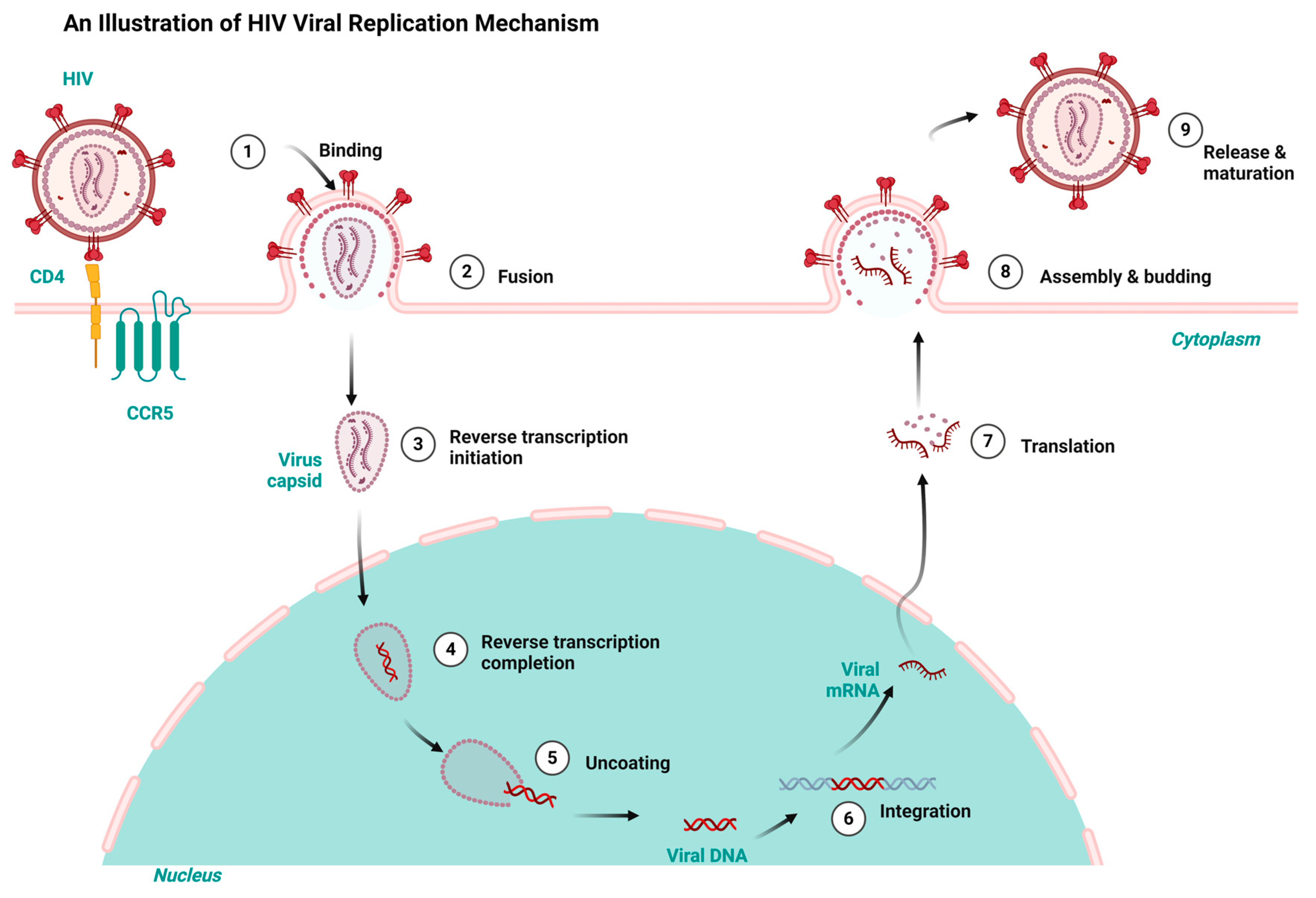

| Serial Number | Drug Names | Target Infections | Likely Side Effects | References |
|---|---|---|---|---|
| 1 | Tenofovir Disoproxil Fumarate (TDF) | HIV and HBV | Renal failure, reduced bone mineral density, nausea, and diarrhoea | [8] |
| 2 | Lamivudine (3TC) | HIV and HBV | Nausea, headache, lactic acidosis | [9] |
| 3 | Emtricitabine (FTC) | HIV and HBV | Headache, gastrointestinal problems, hyperpigmentation and fatigue | [10] |
| 4 | Efavirenz (EFV) | HIV | Neuropsychiatric issues, rashes, and elevated liver enzyme | [11] |
| 5 | Dolutegravir (DTG) | HIV | Headache, insomnia, weight gain, hypersensitivity issues | [12] |
| 6 | Zidovudine (AZT) | HIV | Myopathy, nausea, vomiting, anaemia, neutropenia | [13] |
| 7 | Ritonavir/Lopinavir (LPV/r) | HIV | Gastrointestinal issues, elevated liver enzyme, lipodystrophy, elevated level of blood lipid (hyperlipidaemia) | [14] |
| 8 | Entecavir (ETV) | HBV | Fatigue, headache, dizziness, abdominal pain, and nausea | [15] |
| 9 | Tenofovir Alafenamide (TAF) | HBV | Headache, abdominal pain, renal and bone problems | [16] |
| 10 | Adefovir Dipivoxil (ADV) | HBV | Headache, weakness, abdominal pains | [17] |
| 11 | Pegylated Interferon Alfa-2a (Peg-IFNα2a) | HBV and HBC | Fever, flu, neuropathy, anaemia | [18] |
| 12 | Telbivudine (LdT) | HBV | Elevated creatine kinase, myopathy, peripheral neuropathy, fatigue and headache | [19] |
| Name of Drug | Mechanism of Action | Disadvantages | Class of Drug | Two-Dimensional Structures as Adapted from PubChem | References |
|---|---|---|---|---|---|
| Adefovir Dipivoxil (ADV) | Useful for lamivudine resistance patients. It functions by inhibiting HBV DNA polymerase. | Lower efficiency when compared to newer drugs and an increased resistance in prolonged usage which needs strict monitoring. It also has nephrotoxic effects. | Nucleoside Analog | 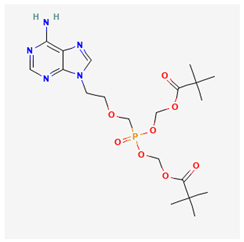 | [85,86,87] |
| Tenofovir Disoproxil Fumarate (TDF) | Incorporates into the viral DNA resulting in the inhibition and premature termination of HBV DNA polymerase. | Prolonged usage results in renal and bone mineral problems. Caution and monitoring is also required for patients with associated kidney problems. | Nucleoside Analog | 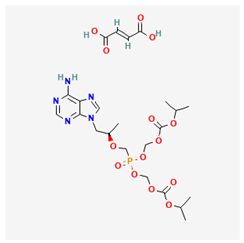 | [88,89,90] |
| Lamivudine (3TC) | Terminates viral replication through the inhibition of HBV DNA polymerase. | It requires combined therapy and is only good for short-term use due to an increased resistance rate in prolonged usage in monotherapy. | Nucleoside Analog |  | [91,92,93] |
| Emtricitabine (FTC) | Functions as a combined therapy with tenofovir for co-infection (HIV–HBV) by incorporating into viral DNA and preventing the replication. | Reduced potency due to cross resistance in a combined therapy with lamivudine. | Nucleoside Analog | 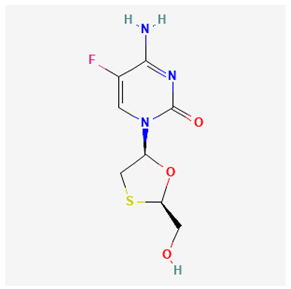 | [10,94] |
| Entecavir (ETV) | Effectively terminates the HBV DNA polymerase chain resulting in an inhibition of the HBV replication. | Ineffective for HIV–HBV co-infection and not recommended for HBV patients with lamivudine resistance. | Nucleoside Analog | 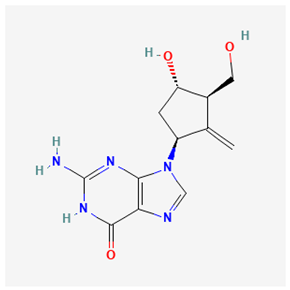 | [95,96] |
| Nevirapine (NVP) | Inhibition of HBV reverse transcriptase and the disruption of viral DNA formation. | Increased risk of hepatotoxicity and accelerated drug resistance. | Non-Nucleoside Analog | 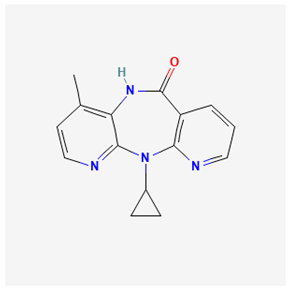 | [97,98] |
| Efavirenz (EFV) | Incorporates into HBV polymerase and prevents the viral replication. | Neuropsychiatric side effects and reduced potency for HBV mono-infection. | Nucleotide Analog | 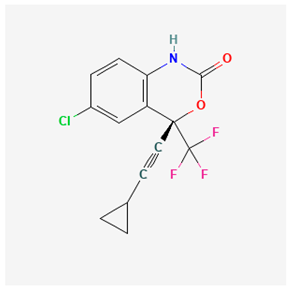 | [99,100] |
| Tenofovir Alafenamide (TAF) | TAF is an improved brand of TDF. It inhibits HBV DNA polymerase replication. | TAF has kidney and bone problems, including other side effects in comparison to TDF. | Nucleotide Analog | 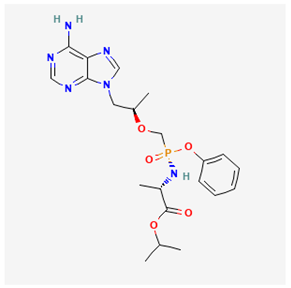 | [101,102] |
| Atazanavir (ATV) | Inhibition of HBV protease-like activities and interference with viral maturation. | Functions effectively when boosted and has a tendency for increased liver enzymes. | Protease Inhibitor |  | [103,104] |
| Lopinavir/Ritonavir (LPV/r) | Functions as a combinatory therapy for the inhibition of HBV replication, by modulating the host immune response. | Not originally approved as HBV drugs but has shown a level of potency in reducing the HBV DNA viral load. It has side effects, including gastrointestinal and lipid malfunctions. | Protease Inhibitor | 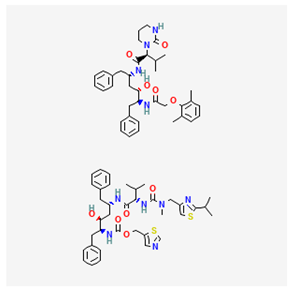 | [105,106] |
| Raltegravir (RAL) | Inhibits the HBV DNA incorporation into the host genome thereby preventing replication. | Lower barrier to resistance and reduced clinical data in HBV. | Integrase. Strand Transfer Inhibitors | 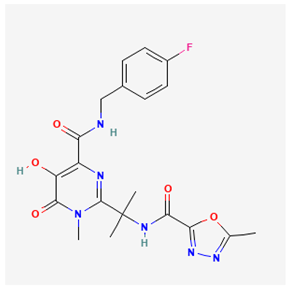 | [107,108] |
| Dolutegravir (DTG) | Blocks HBV DNA incorporation and suppresses viral persistence. | Danger of hepatotoxicity and potential weight gain. | Integrase. Strand Transfer Inhibitors | 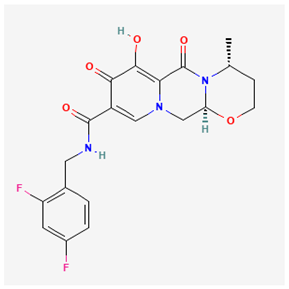 | [109,110] |
Disclaimer/Publisher’s Note: The statements, opinions and data contained in all publications are solely those of the individual author(s) and contributor(s) and not of MDPI and/or the editor(s). MDPI and/or the editor(s) disclaim responsibility for any injury to people or property resulting from any ideas, methods, instructions or products referred to in the content. |
© 2025 by the authors. Licensee MDPI, Basel, Switzerland. This article is an open access article distributed under the terms and conditions of the Creative Commons Attribution (CC BY) license (https://creativecommons.org/licenses/by/4.0/).
Share and Cite
Ugbaja, S.C.; Omerigwe, S.A.; Ndlovu, S.M.Z.; Ngcobo, M.; Gqaleni, N. Evaluating the Efficacy of Repurposed Antiretrovirals in Hepatitis B Virus Treatment: A Narrative Review of the Pros and Cons. Int. J. Mol. Sci. 2025, 26, 925. https://doi.org/10.3390/ijms26030925
Ugbaja SC, Omerigwe SA, Ndlovu SMZ, Ngcobo M, Gqaleni N. Evaluating the Efficacy of Repurposed Antiretrovirals in Hepatitis B Virus Treatment: A Narrative Review of the Pros and Cons. International Journal of Molecular Sciences. 2025; 26(3):925. https://doi.org/10.3390/ijms26030925
Chicago/Turabian StyleUgbaja, Samuel Chima, Simon Achi Omerigwe, Saziso Malusi Zephirinus Ndlovu, Mlungisi Ngcobo, and Nceba Gqaleni. 2025. "Evaluating the Efficacy of Repurposed Antiretrovirals in Hepatitis B Virus Treatment: A Narrative Review of the Pros and Cons" International Journal of Molecular Sciences 26, no. 3: 925. https://doi.org/10.3390/ijms26030925
APA StyleUgbaja, S. C., Omerigwe, S. A., Ndlovu, S. M. Z., Ngcobo, M., & Gqaleni, N. (2025). Evaluating the Efficacy of Repurposed Antiretrovirals in Hepatitis B Virus Treatment: A Narrative Review of the Pros and Cons. International Journal of Molecular Sciences, 26(3), 925. https://doi.org/10.3390/ijms26030925






